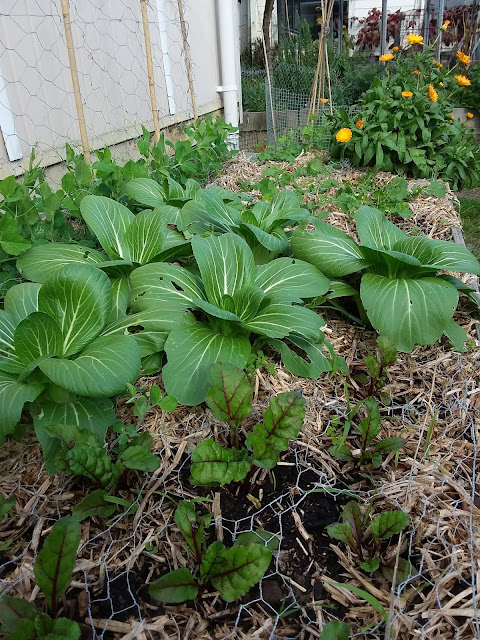Learning All The Time
I did almost everything wrong when it came to growing kumera. I do a lot of learning as I go. If I'm growing something new, I research how and when to plant it. I might not research when and how to harvest it until I start to get the feeling that it may be ready soon.
I was really very mistaken about when to harvest kumera. I knew they needed a long growing season, and I had read that you harvest when the leaves start to die back. I also figured on them being similar to potatoes: if you harvest them late, they just sit in the ground over Winter and there's no harm done.
I'm here to tell you what I've learned since. They should be harvested 120-150 days after planting out the shoots - that's 3-4 months of growing. While some sources say to harvest when the plants die back, there are some good reasons to harvest once their growing period has been reached and before the leaves die. For one thing, the leaves are a tasty vegitable in their own right and are commonly eaten in some countries. Knowing this, I had sampled a few leaves raw off my plants earlier in the year, and they were pretty tasty. But once I came to harvest, it was too late to make a meal of them. Look at these things before the frost got to them:
Don't they look tasty?
I also really didn't know a thing about curing. The recommendation is to set them down in the sun for a couple of days, ideally at 30 to 35 degrees C. This is really not an option in the beginning of Winter. It's not even neccesarily an option in the middle of Summer where I live, but the temperature would have been closer. The sunroom gets near enough even on a sunny day in early Autumn. Looking back at my photos, I had my kumera in by the end of November, so could have been harvesting in February or March. Given our climate, though, I really should have planted them sooner so I could get them out and curing on a nice hot day at the end of Summer.
I knew I was putting them in a little late, but I had reasons. This property came with raised beds, and the one I'd picked out for the kumera needed some work. The raised bed was only wood boards on two sides; the other two walls were nothing but stacked up pieces of broken concrete. This is what it looked like originally:
I mean, really, who does that?
It was really ugly and did not look like a fun to garden. But it took me some time to get around to dealing with it. I asked my Dad to come over with his circular saw one day and help me build out the other two sides. We used some of the numerous wooden boards that were stacked up in the potting shed when we got here. The results:
Yes, we had to dig out a lot of the soil to do this work. This was not bad as the soil was very poor quailty. I filled it back up with some of the pile of top soil I had bought for various garden work, and of course some bags of compost, followed by the usual soil ammendments.
Here's another thing I got wrong, though. I should have added more compost. When it came time to harvest the kumera, the soil was still rather clay-heavy and dense. I harvested quite a lot of kumera - maybe 25 - but they were all long, thin and twisty. I suspect the soil was one reasons for this, but I'm not sure. Kumera grow in clusters around the points where the shoots grow out of the ground - and thus where the roots grow down. Here is one such cluster from my garden, mid-harvest:
Here is what I didn't know about curing kumera. One reason to cure them is to dry out the skins, sealing in moisture and making them keep for longer. This reason I am familiar with, as is the same for many veggies such as garlic and onions. But there is a second reason: cured in warm conditions, more of the starches convert into sugars, making the tubers sweeter. With some research online, I found advice for curing if you don't have 30 plus degree weather: if you can provide temperatures in the 20's, cure for a couple of weeks to get similar results. So I am curing them in the hot water cupboard at night and on cloudy days. The hot water cupboard keeps at abut 20 even on cold days. On sunny days I set them in the sunroom, where it gets up to 25 even when it's cold outside. I'll try this for a couple of weeks and then test the results. By which I mean, roast up a few kumera and see how they tasty they are.
I'm no kind of expert. The things I don't know about gardening could fill many volumes - possbly a small library. But I don't let this slow me down. I am learning all the time, and sometimes I learn best by making mistakes.
Its Winter, and I've got very little left to plant in the garden before Spring. I'll be putting in the garlic and the last of the multiplying onions the next time I get some free time on a dry day. This time of year, the ammount of work to do out in the garden slows down. Winter is a great time to brush up on gardening knowledge. For my birthday, I asked my parents to take an online gardening workshop with me, from an organisation I greatly respect (Koanga Institute). I love that, when it comes to gardening, there is always more to learn.






Comments
Post a Comment